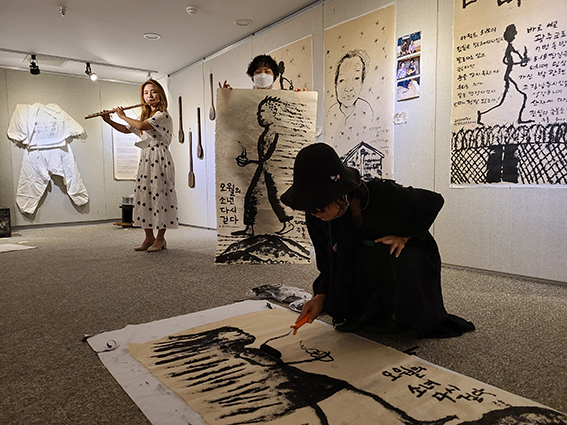An Artist Couple Living in the Arts
By Kang Jennis Hyun-suk
FIRST ENCOUNTERS
A couple of months ago, I went to a gallery cafe on Gwangju’s Art Street (예술의 거리). A lot of wonderful artworks were hanging on the walls in the cafe. Among them, a little surface relief caught my eye. It was a nude. I asked the owner of the café whose work it was. The lady said that her husband bought the relief as a congratulatory gesture at an artist couple’s wedding. The couple was Ju Hong and Goh Geunho. She said the two artists’ wedding was held in a gallery, where they exhibited the works that they had made during their dating period. The surface relief was also made during this time by Goh. How romantic! I thought the artworks were like love letters the dating couple sent to each other.
Thinking back, I remembered that I had once previously seen a piece of Goh’s work. It was a sculpture of two molded clay men. One was an older man in a loose suit. He had bent shoulders as if he had carried many heavy burdens on his back throughout his life. And the other was a young man in jeans with a skull-shaped buckle. One of his eyes was hidden by his long hair, and his arms were folded as if he was challenging the world. The title of the sculptures was “Father and Son.” I could empathize with the work. The era of my parents required going through a lot of difficulties on this land in the early 20th century. Thanks to them, the next generation could enjoy the fruits of life, but that is also why we do not have the ability to understand the shadows of the former generation. At the time, I wondered who this artist was who had depicted the stark contrast between the two generations. From these two encounters, I wanted to know more about this artist duo and thought that I could do so through an interview. I set up separate interviews for the two of them because I guessed that the artistic expression they were pursuing might be quite different. Before going to the interview with artist Goh, I browsed through his recent artworks on the internet. His works have changed over the years. Recently, Goh is known for his pop art. I had heard the term pop art before, but I was not sure exactly what it referred to. So, I headed to the library.
This is my favorite part of writing art articles. Going to the library helps me to learn about the artists. What I learned from the library was that “pop art,” an abbreviation for popular art, was originally born in England in the mid-1950s. After World War II, pop art emerged as an art movement in England and the United States. There are several world-famous pop artists you might know: Roy Lichtenstein, who is known for the work Happy Tears; Andy Warhol, who asserted that everyone in the world should be able to enjoy the arts equally, just as everyone can enjoy the same taste of Coca-Cola; and Jean-Michel Basquiat, who brought wild graffiti into the galleries. “But are there pop artists in Korea?” I thought. The concept of pop artists was a little surprising to me.
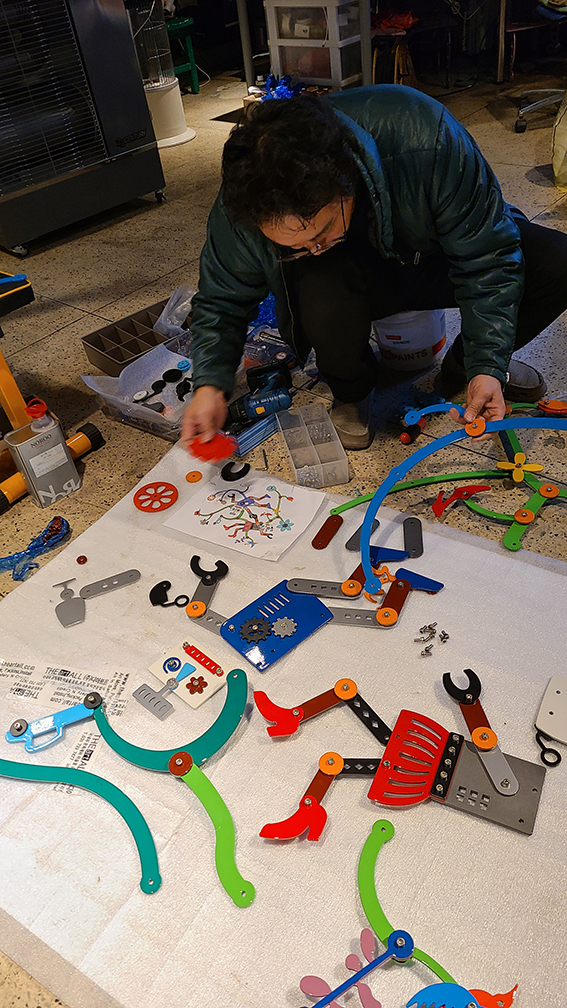
GOH GEUNHO
At last, I could meet artist Goh at his studio in Gwangju. When I followed him up to his studio, I thought I was in an animation park or Charlie’s Chocolate Factory. Colorful metal pieces were connected with nuts and bolts to create interesting stories. When I saw a bike emitting flower farts flying against the wall, I could not help but laugh. I could see a lot of metal creatures. Don Quixote on Rosinante; Darth Vader, who spread the phrase “I am your father” worldwide; Wonder Woman, who was my childhood idol; and the Little Prince, who went back to his asteroid, B612. I could not help but enjoy myself with the various poses of these metal heroes.
In one of Goh’s artworks, there was a Buddha sitting and thinking inside a door. Behind the door, there was a line of people waiting earnestly for the Buddha to finish his thinking. The jovial aspect is that the waiting metal characters are from popular paintings by Klimt, Seurat, Picasso, and Munch. I felt that he was depicting diverse characters of common people in diverse waiting poses. I just dropped my jaw and said, “Wow” again and again. On the way up to the studio, I also saw his words written on a board. They read: “There is no point in life unless you are happy.” I think his words on life are expressed in all of his works.
After this amazing “tour,” we sat down in Goh’s studio for the interview.
Jennis: Where on earth does your creative mind come from? Perhaps you are the artist least influenced by schooling, not fitting into a mold that society may expect.
Goh Geunho: How did you know that? My nickname is Gong-dam.
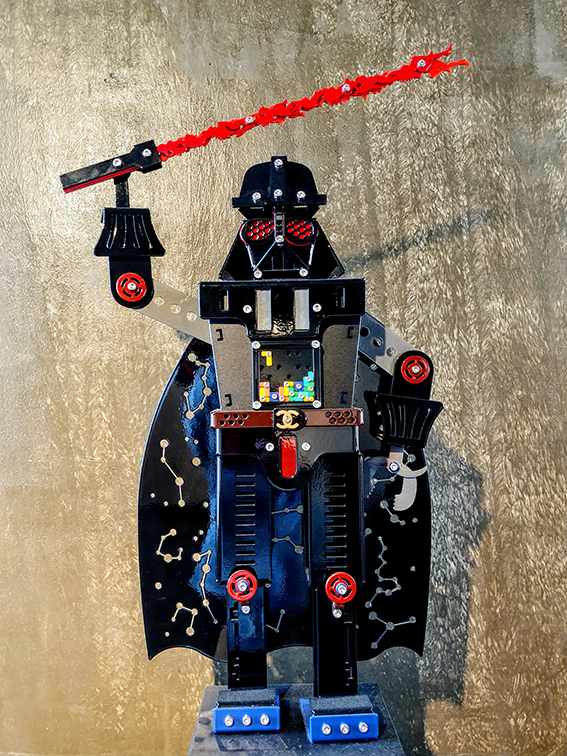
Jennis: What does that mean?
Goh Geunho: When I was a high school student, my teacher asked me why I had built a high barrier against studying. Actually, I was not interested in studying but in doing art at that time. After that, I call myself Gong-dam, or “wall against study” in Korean.
Jennis: So, you were able to build your creativity safely on the other side of the wall.
Goh Geunho: Right. I could not catch up with the speed of my bursting ideas when I was young. But nowadays, they come at a proper speed so that I can jot them all down in my notebook.
Jennis: How positive you are! Can I ask what your childhood was like?
Goh Geunho: When I was young, my mother ran a bakery. Next to the bakery, there was an underwear shop and the owner of the shop always gave me the remaining cardboard paper after selling her goods. I kept myself happy by making robots and cars by cutting and pasting the cardboard.
Jennis: So, you grew up as a pop artist? Then did you major in sculpture in college?
Goh Geunho: I used to do fine art. I liked painting since I was young. One day, Prof. Ko Jong-soo, who taught us sculpture in a practical course for experiencing various fields, told me that I was talented in sculpture.
From that time, I became attracted to the field of sculpture – creating something that did not exist before – so I changed my major. And I have been doing pop art sculptures for the past 20 years, coloring and assembling plate steel.
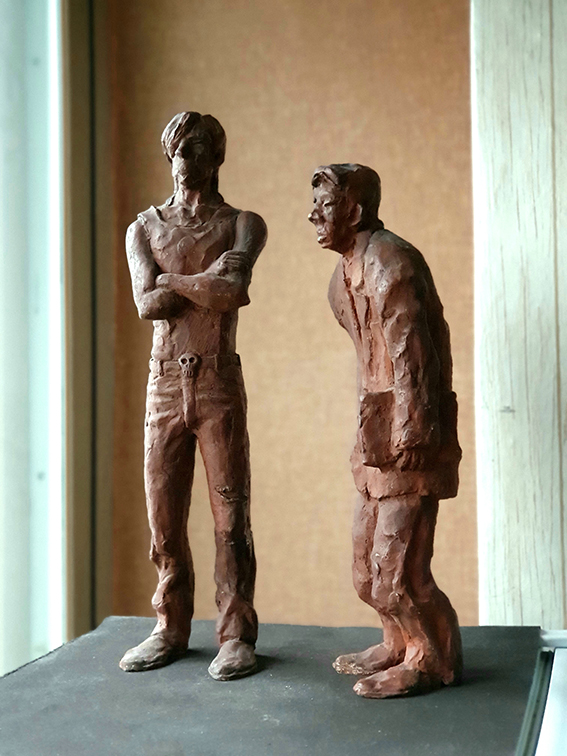
Jennis: As a pop artist, when is the happiest moment for you?
Goh Geunho: When I exhibit at art fairs around the world, I am happy that my booth is popular with the children.
Jennis: I can imagine. What do you think your next direction will be?
Goh Geunho: With the encouragement of those who miss my old sculptures, I am now planning to establish a studio in Yeongam.
Jennis: I hope to see your new sculptures and pop art in art galleries soon. Thank you for your time.
JU HONG
Most artists’ works are displayed at exhibitions, and people who want to possess them can purchase them at the art galleries. However, in the 21st century, the art process itself has become the art. Ju Hong is an artist who is trying to be free from the constraints imposed upon art and the art industry. Sometimes she draws on paper or cloth with the freedom of a musician’s creativity. Sometimes she dances or creates a story with fine sand. But there is something in common in all her diverse artworks: conveying the message of nature or words of consolation to the people.
I saw Ju Hong’s artwork in a downtown Gwangju art gallery, and we were able to talk about her artworks during our interview.
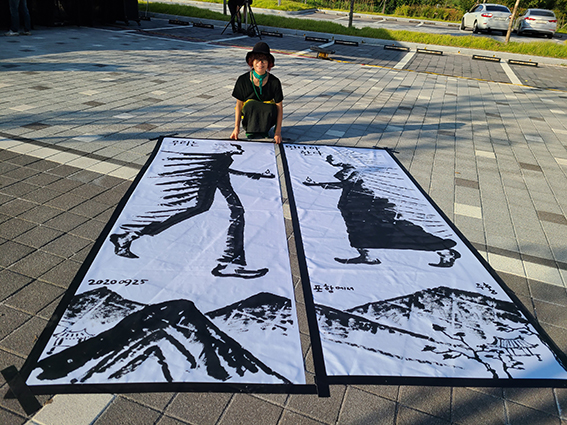
Jennis: A few days ago, I saw your work with your left-handed writing on Korean paper. Is that one of your early works?
Ju Hong: Yes, it was the poem “On the Way to Eunju-sa” by Yim Dong-hwak. Eunju-sa [in Naju] is a temple that has a story handed down for centuries. A thousand years ago, the people on this land believed that if a thousand Buddha statues and a thousand pagodas could be built in one night, the ideal world could be realized. But the dream of the common people did not come true because their efforts were short by one statue. The poet recalled May 18 from the broken statues scattered here and there at Eunju-sa. I sympathized with his poem and expressed it as a painting.
Jennis: I see. Was there any special reason to paint and write with your left hand?
Ju Hong: One day, I had a chance to observe my actions one by one. I was so used to drawing with my right hand, and sometimes the hand went first without me even thinking about it. It is hard for quickly written and splendid words to convey one’s true mind. As you know, children’s crooked drawings express their feelings well. I also wanted to convey my mind with my unfamiliar left-handed drawing.
Jennis: I see. I heard that you stayed in India for years when you were a young artist. Would you tell me the story of your stay there?
Ju Hong: I majored in Korean painting at Chonnam University, and I did my master’s program in fine art at ChungAng University. So, I loved to combine Western materials with traditional black ink on white paper. After completing my master’s, I had a chance to go to India to prepare for a contemporary art exhibition between Korea and India in 1995. The president of Varanas Hindu University expressed an interest in my paintings, and he suggested that I teach Korean paintings to his students.
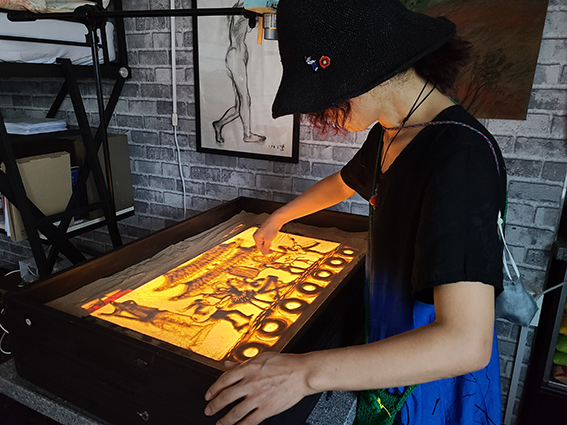
Jennis: Wow, did you teach Korean art in English?
Ju Hong: There is a saying, “Art overcomes any language barrier.” Fortunately, I was able to teach art with simple English.
Jennis: How was your stay in India overall?
Ju Hong: I stayed in India for four years, coming and going eleven times. I have written my story of India as a newspaper column. It was a wonderful experience for me, but because I could not eat properly, it damaged my health.
Jennis: So, you came back to Korea?
Ju Hong: Yes. I stayed near a temple on the outskirts of Gwangju to restore my health.
Jennis: I am curious to know how you met your husband, artist Goh Geunho.
Ju Hong: It happened suddenly. One autumn day, as I was watching the falling leaves, I realized I was in my mid-30s. I suddenly missed having someone to have my meals with. Then I thought of Goh and called him to have dinner together. We had known each other as artist colleagues. And he said yes! But we were both too shy for just the two of us to meet. So, we brought some friends along, and it became a big happy dinner. That was the beginning of our story.
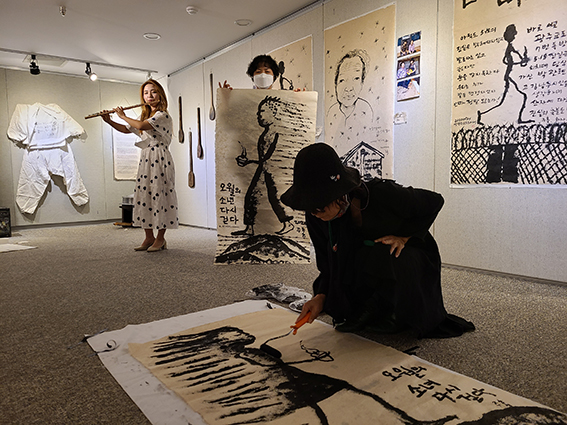
Jennis: That is how this artist couple was born! And, I also heard that you wrote books for your children.
Ju Hong: Living as artists, especially since our art was experimental, we did not make much money at that time. But we wanted to give our children something special as artist parents. Their father made artworks out of junk materials and took pictures of the process, and as a mother, I wrote a story and made a picture book for it. The title of the book is The Worn-Out Bike (고물자전거). Luckily, the book was then introduced on a children’s TV program and became popular. Another TV program filmed the process of making picture books in a documentary and aired it nationwide. Later, the book was selected as an outstanding book at the Bologna Book Fair in Italy and at the Frankfurt Book Fair in Germany.
Jennis: Wow, what a story! Your love for your children was surely conveyed to the people. By the way, I read your profile and found that you are a healing artist. How did you come to want to be a healing artist?
Ju Hong: After my marriage, I needed work to earn a living. Fortunately, I had a certificate as an art teacher, so I started to work as an art teacher on an island. The island of Anjwado (안좌도), one of the islands of Sinan [off the west coast], is the hometown of the famous Korean painter Kim Hwan-gi. However, there were some students there who lived with their grandmother instead of their parents and who had left the island to make money. Some of the children were mentally retarded , being unable to write letters or numbers. I taught them timetables and the letters of Hangul through art in their after-school classes. They surprisingly improved themselves a lot. Through this experience, I learned that painting has the power of healing, and I wanted to study more about it. So, I went to Wonkwang University for a doctorate in art therapy.
Jennis: Amazing, I respect how you strive to develop yourself constantly. Now you work as director of a gallery, The Box of Thoughts (생각상자), and as curator of May Hall. Is May Hall concerned with Gwangju’s May 18?
Ju Hong: Right. May Hall is located across from the Asia Culture Center (ACC). In 2012, at the suggestion of pastor and artist Im Uijin, citizens and artists joined to create a space to preserve the spirit of Gwangju.
Jennis: I see, but the ACC was built in memory of and to keep the spirit of democracy, was it not?
Ju Hong: Yes, but some of the citizens, including some artists, thought that the spirit of Gwangju’s citizens could not be properly preserved under the government’s control. So, every Saturday at 2 a.m., several people got together and painted graffiti on the walls of the ACC construction site. The people of diverse generations got together as one at that time and made a plan to create a space to preserve the spirit of Gwangju citizens. That is May Hall.
Jennis: And it has already been ten years since then! This might be a silly question, but what made you concerned about May 18? And would you tell me what your next steps as an artist might be?
Ju Hong: I think the experience of May 18 at a young age has guided me through my whole life. I have kept thinking about why it happened, how we can heal ourselves, and what we leave for our following generations as a legacy of democracy. As an artist, I will keep finding ways of doing this. I think that artists exist to help people discover their abilities for self-healing.
Jennis: It is said that art has come about to give comfort and hope from primitive times. It is amazing that you constantly develop yourself in diverse way as an artist. Thank you for your time.
AFTER THE INTERVIEWS
Artist Goh Geunho achieved excellent results at Hong Kong’s Asia Auction Week and Singapore’s Larasati Auction, and his works were also welcomed at the Tokyo Modern Art Fair and the COEX International Art Fair in Seoul. His Heroes series, which was created from cartoon and historical heroes, has been continuously popular. I wonder who his next hero will be. Ju Hong is working as an artist of Gwangju and for Gwangju. She is an artist with soul and wants to be a guerrilla of culture. I support the lives of this artist couple, who are different but similar, and who are ardent supporters of each other.
The Author
Kang “Jennis” Hyunsuk is a freelance English tutor and a once-in-a-while interpreter. She worked for the Asia Culture Center during its opening season and likes to grow greens and walk her dog. Every weekend, she goes to the countryside and takes photos of nature with her husband.





